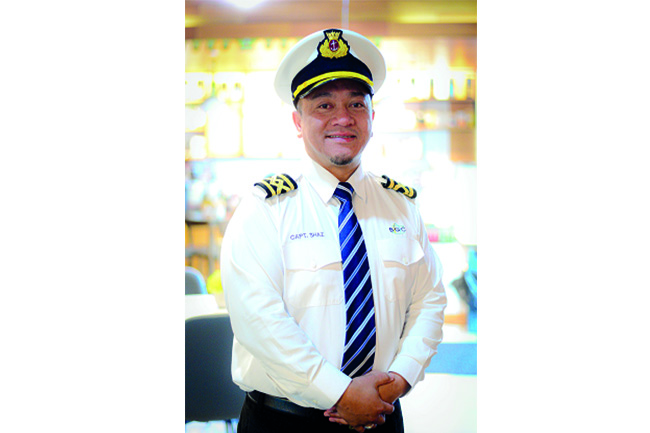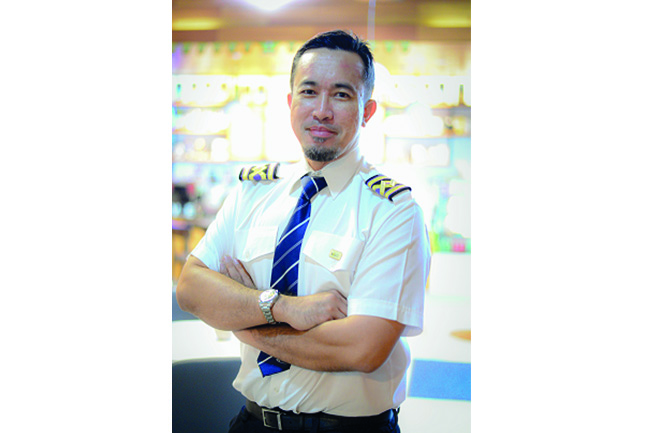 Danial Norjidi
Danial Norjidi
Since its launch in 2011, ‘Day of the Seafarer’ has been observed around the globe each year on June 25 to recognise the invaluable contribution that seafarers make to international trade and the world economy.
For 2022, the theme of the occasion is ‘Your voyage – then and now, share your journey’, celebrating maritime voyages and journeys.
In a video message to mark this year’s celebration, International Maritime Organization (IMO) Secretary-General Kitack Lim said, “Every day, hundreds of thousands of seafarers are underway on ships, while others take their well-deserved break, getting ready for their next voyage. Their ships are key movers of global trade, and engines of the global economy, transporting cargoes such as food, medicines, electronics and more. Without seafarers, there would be no shipping.”
He noted that, after two years, the COVID-19 pandemic still presents a challenging working environment, with continuing difficulties in conducting crew changes and gaining access to medical care and shore leave. “IMO continues to urge member states to support seafarers by designating them as key workers, so that every seafarer’s maritime journey can move into smoother waters.”
To mark this year’s occasion, two experienced mariners from Brunei Gas Carriers (BGC) shared insights on what it means to be a seafarer.
Seafaring, then and now

Captain Mohammad Shazelli bin Haji Damon is one of six fleet captains for BGC. Starting as a cadet back in 2003, he moved up the ranks, collected the necessary sea times and passed his certificate of competency as an unlimited master mariner in 2019, before doing his command assessment in September 2020 and then subsequently becoming a full-fledged captain in February last year.
Sharing what Day of the Seafarer means to him, Captain Shazelli said, “Words that come to mind are: sacrifice, safety, teamwork, leadership, trust, honour and pride of the job that you’re doing. This is because when you make the decision to jump into the industry of the marine world as a seafarer, you are ultimately sacrificing your time where you could be with your family in the hope that you could give them a better life.”
The captain also spoke on how things have evolved in seafaring over time from when he started to the way things are now. “First and foremost I would say the safety part of it. That’s unquestionable.”
Providing an example, he noted that modern times have seen the development and use of safety harnesses and span-sets for working at height. Another example is in enclosed space entry, also known as tank diving, which has seen the implementation of a permit to work being needed for each particular job, meaning that all the safety and equipment preparations would be checked and rechecked again to ensure the oxygen is sufficient and that there are no hazardous gases.
“So in terms of safety we are moving in the right direction,” he affirmed.
Another key area he noted was in terms of communication and connectivity. “Reaching out to our family, our loved ones, back then you would write an email and send it off, and it would arrive with the recipient two days later.”
Nowadays, however, things are much different. “Now you have internet connectivity, you have WiFi, and it’s normal. It’s like being ashore.”
In terms of navigation, he said that things have changed dramatically with the use of the Electronic Chart Display and Information System (ECDIS) instead of paper charts. “Basically, you used to have charts where you had to use a pencil and ruler to draw the course. Now you can do everything on ECDIS, a digital system. Our ships are certified to sail paperless, which means that we only carry contingency charts. A good thing about ECDIS is you can find all the charts online and they will be sent to you right there and then.”
Digitalisation has also helped make things easier in other ways. “We used to carry publications such as the Admiralty List of Lights (ALL) or the Admiralty List of Radio Signals (ALRS) – we’re talking about 20 or 30 books. We don’t carry them anymore, as everything is now digitalised.”
In addition, while people previously sailed using a magnetic compass, gyro compasses are now the norm.
“There are some things that we still practice just to make sure that we still have the touch of using them, such as a sextant. If you don’t have GPS and you don’t have a gyro compass, you need a reference to navigate the ship, so you have a sextant, navigating by land or by celestial bodies – the sun, the stars and the moon.”
Speaking on challenges currently faced by seafarers, Captain Shazelli highlighted that things have changed significantly since the COVID-19 pandemic struck the world.
“You don’t have the luxury to do the normal length of tour anymore. For the crew, it used to be two and a half months, and for the officers it was four months,” he shared. “But since COVID-19, it’s really hard to get your reliever due to restrictions, both from the border and immigration, especially when you take the other countries into consideration.”
Additionally, since the pandemic, the voyage order is fluid, the captain said. “So you would be getting instructions from the officer saying you’re going to, for example, Japan. And then probably four or five days later you’re going to be rerouted to Korea, and then because of that, the relievers who are supposed to be joining on a particular date have to wait until the rerouted voyage has completed and come back to Brunei.”
“Because of that, the normal tour during COVID-19, I would say, is about four to six months. That’s an add-on of almost two to three months.”
“Initially it was really hard for us, including myself because I had to do longer trips twice – six months on one trip and another six months in the next trip. Initially it was really tough,” he said, noting that adapting with the changes is difficult, but is “an accepted hardship”.
“It’s also really hard for the families back at home,” said the captain. “As such, internet connectivity helped a lot.”
He added that “the people you work with at sea, whether they are Bruneian or from a different country or culture, when you’ve been sailing with them since 2003, you’re practically growing up with them, and they’re the ones who are actually bringing you up to where you are as a captain or chief engineer. So it’s more like a family-oriented working environment.”

Another seasoned seafarer to speak on his experience was Acting Fleet Manager at BGC, Pengiran Haji Nor Hazman bin Pengiran Haji Abdul Hamid.
“I started my cadetship in 2000 as one of the first cadets of BGC’s Bruneianisation project for local seafarers,” he said. “Like Captain Shazelli, we went through three years of cadetship. After the cadetship, we progressed through our ranks, from fourth engineer to chief engineer.”
“I started as a steam engineer up until 2012, and then qualified as a chief engineer. I then did my conversion from 2012 to 2015 for motor chief engineer. In 2016, I was assigned back to the office as part of the team to assist with the transition of BGC from a ship owning company to a ship managing company.”
Reflecting on the cadetship programme, Pengiran Hazman shared, “When I started my cadetship, the first thing that was thrown to me was that this field in Brunei is very new, and I would be part of those pioneering this career. There was no Bruneian chief engineer yet at that time. There were also very few captains.”
“I saw that the maritime sector had quite clear prospects; just go through your career and you can get to the end. From fourth engineer, third engineer and second engineer to chief engineer, it’s quite well laid out.”
Pengiran Hazman was determined to become a chief engineer, but knew the sacrifices involved in a seafaring career.
“I set my expectation right from the beginning that I was going to be away from the family, and I was going to have a very limited social life. I remember the recruitment officer told us that the career you take will change you as an individual, which is correct. You are more independent, resilient and open. What he said was true.”
“My career in seafaring was all about study and work, until completion. It was quite tough at the time, because we had four months away, and then two months’ leave, so the two months’ leave was very valuable for us. In a year, we basically spent less than four months with family, and the rest of the time you would spend away from them. I also realised the distance with my friends, because at the time while the country had internet, ships did not.”
“As a seafarer, your exposure to the world is limited to your seafaring life. You can imagine, in a year, you only spend four months at home – four months socialising. The rest of your life in a year is confined in a steel box.”
“So it’s also about how you’re going to bring yourself up, how you’re going to handle your emotions, and how you handle people. You have to be very resilient,” he added.
In 2019, BGC marked the significant milestone of achieving a Document of Compliance (DOC), officially recognising BGC as a full-fledged ship manager.
Looking back at how this was achieved, Pengiran Hazman said, “The moment we had our own captains and our own chief engineers, that set the tone. We had the components to do it, so the management decided that we were ready to embark on managing our own ships.”
“It was a joint project for the transition from our previous technical manager Shell International Trading and Shipping Company Limited (STASCO). Back then, BGC was a ship owning company and agreed that it was about time that it had its own resources and the right personnel to take on the role of managing the vessels.”
“I think this is the commitment shown by the management team and the shareholders. That is reflected by the seafarers, from that belief that we are able to embark further in this seafaring career and also managing ships.”
Meanwhile, regarding Day of the Seafarer, Pengiran Hazman said, “I think it’s a reminder of the unsung heroes, because seafarers work in the background of the economy. When you look at most of our modes of transport, more than 70 per cent of the world is covered by the sea, and most of our products are delivered by the sea. When you think about planes, even plane parts are transported by sea from one continent to another, especially the larger parts.”
“Seafarers are also unsung heroes because they spend their time away from their families. So Day of the Seafarer is also to remind the families that their loved ones at sea sacrifice their time to contribute to the economy and for the families’ livelihoods.”







